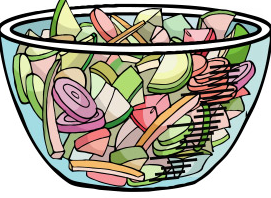Savoring Calories
 Let’s face it, calories count... but savoring them is even better. It’s time to forget the word “diet” and give up on deprivation. Enjoy your food and be mindful of what you are eating. Embrace the fact that permanent weight loss -- and a lifetime of successful weight management -- depends on calories in versus calories out. However, it’s the quality of the calories the make a difference to your overall health. Enjoy a variety of plant foods like fruits, vegetables, beans, legumes, nuts, and seeds. Add some lean meats and a smattering of healthy fats like avocado or vegetable oil and you should be good to go. Note that these foods are all nutritious and often minimally processed.How Whole Food Calories Stack Up:
Let’s face it, calories count... but savoring them is even better. It’s time to forget the word “diet” and give up on deprivation. Enjoy your food and be mindful of what you are eating. Embrace the fact that permanent weight loss -- and a lifetime of successful weight management -- depends on calories in versus calories out. However, it’s the quality of the calories the make a difference to your overall health. Enjoy a variety of plant foods like fruits, vegetables, beans, legumes, nuts, and seeds. Add some lean meats and a smattering of healthy fats like avocado or vegetable oil and you should be good to go. Note that these foods are all nutritious and often minimally processed.How Whole Food Calories Stack Up:
- Whole grains: 1 serving = 80-100 calories. That’s 1 slice of bread, 1/3 cup of brown rice, 1/2 cup of oatmeal, ¾-1 cup of high-fiber cereal, etc.
- Whole fruits: 1 serving = 60-80 calories. Think 1 medium apple, orange, pear, etc, 1 cup of cut fruit, ¼ cup of dried fruit, or ½ cup of fruit juice.
- Vegetables: 1 serving = 25-50 calories. Try 1 cup of raw vegetables, ½ cup of cooked vegetables, ½ cup of V/8 juice, etc.
- Protein: 1 serving = 70-160 calories. That serving is 1 ounce of lean meat, poultry, or fish, ½ cup of beans, 1 egg, 1 tablespoon of peanut butter, or 1 ounce of nuts.
- Fat: 1 serving = 45-50 calories. These servings are small. Think 1 teaspoon of vegetable oil, 1 tablespoon of regular salad dressing, 1 slice of bacon, 1/5 of an avocado, etc.
Tips for Cutting Calories:
- Decipher the Nutrition Facts panel. Make sure that you are reading the Nutrition Facts for a single serving of food. Often, packaged foods have more than one serving per container. For example, sugar-sweetened iced tea usually contains more than one serving in a bottle. So though it appears as though the bottle only has 80 calories, that’s actually all that’s found in one serving. The bottle has closer to 160 calories.
- Switch to smaller plates. If you eat from a smaller plate, you are likely to eat less food. Choose a salad plate (8 inches) instead of a dinner plate (10-12 inches).
- Be a mindful eater and slow down. This allows you to recognize hunger and fullness cues. It takes your brain 20 minutes to register fullness, so allow your body and brain enough time to sync up before taking a second helping.
- Downsize, don’t supersize. Budget your calories like money. Just because fast food is cheap doesn’t mean that it is worth the calories and fat. A small popcorn at the movie theatre has about 150 calories, but a large can have over 1,000 calories (and that’s without butter).
- Limit alcohol. Many people forget to add up liquid calories. Alcoholic beverages can pack more extra calories than you might think. After all, there are 7 calories per gram of alcohol. That’s 70 calories per ounce (2 Tbs). The higher the proof, the more calories the alcohol has. For example, 80-proof alcohol averages 65 calories per ounce, and 100-proof alcohol has closer to 85 calories per ounce. Plus, when you are under the influence, willpower can go by the wayside!
By Victoria Shanta Retelny, RD, LDN, author of The Essential Guide to Healthy Healing Foods.
